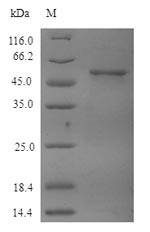The recombinant Human TUBB4A was expressed with the amino acid range of 1-444. The theoretical molecular weight of the TUBB4A protein is 53.6 kDa. This TUBB4A recombinant protein is manufactured in e.coli. The N-terminal 6xHis tag was smoothly integrated into the coding gene of TUBB4A, which enables a simple process of detecting and purifying the TUBB4A recombinant protein in the following steps.
Tubulin beta-4A chain (TUBB4A) is a member of the tubulin family, which constitutes the building blocks of microtubules – essential components of the cytoskeleton. Microtubules are involved in various cellular processes, including intracellular transport, cell division, and maintaining cell structure. TUBB4A is specifically associated with the assembly of microtubules and is expressed in various tissues, including the brain and other organs. Mutations in the TUBB4A gene have been linked to certain neurodevelopmental and neurodegenerative disorders, highlighting the importance of this protein in neurological function. Understanding the role of TUBB4A in microtubule dynamics and its implications for neuronal function is crucial for unraveling the molecular basis of these neurological conditions and may offer insights into potential therapeutic strategies.




